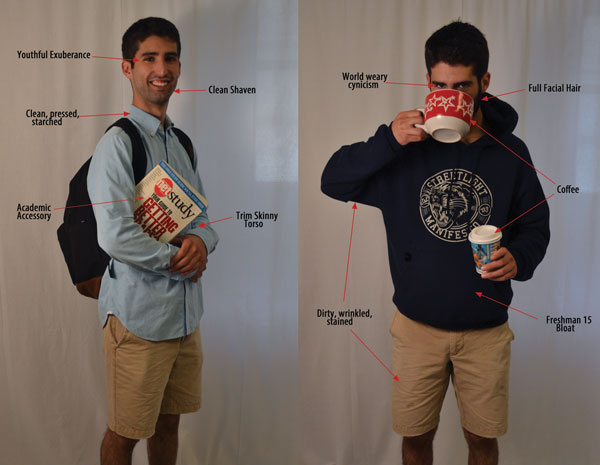
The five-finger discount
THERE’S NO SET profile for an amateur shoplifter, the name given to those who steal items for their own personal use. Mid- dle-aged career men, famous actors (Winona Ryder, anyone?), and university students have all been caught red-handed. A 2007 study by the Retail Council of Canada claimed $3.6 billion worth of goods are stolen each year. It also stated approximately 80 per cent of Canadians have shoplifted at least once in their lives, and one in 10 of us do so regularly. The Fulcrum examines the consumer culture of shoplifting and how it’s costing students more than they realize.
The rationale
Elizabeth Hartman* is a fourth-year student at the University of Ottawa who shoplifted regularly throughout her first two years at the school.
“Every time it was exciting, scary, kind of a thrill really. It’s almost like a game, [where] the stakes are pretty high, the prize is something useful, and you need to be smarter than other people to win,” she explained.
“There are so many things you have to think about,” Hartman elaborated. “You need to make sure you get all the tags or stickers or whatever off, and you have to act calm, which is hard because you
think everyone’s staring at you and your heart is just pounding so hard.”
Why would anyone risk fines, a criminal record, and a whole lot of embarrassment simply to have a few more possessions? Experts give a number of reasons for why shoplifters—students in particular—steal.
Edward Bryan, a loss prevention officer at Sears, reported there are a lot of students shoplifting in the store, most of whom claim to have the same reasons for their actions.
“A lot of students steal. [Maybe] it’s because it’s [that] age group and the demographic and they think they won’t get caught or [maybe] it’s because they just don’t have money,” said Bryan. “That’s usually the biggest thing we’ll hear, ‘I’m a student. I don’t have money.’”
For Hartman, shoplifting was an activity she did with her friends.
“I know how it started. Me and three friends went shopping, and when we left one store, two of the girls were giggling a lot and were just really excited,” she said. “I found out later that they had taken a few pairs of underwear from La Senza.”
Initially unimpressed by her friends’ actions, Hartman eventually had a change of heart.
“I remember being shocked and a little appalled,” she said. “But at the same time, I [was] kind of jealous because they had new lingerie and I had none because I couldn’t afford any. It didn’t seem fair at all, plus they were having fun.”
Hartman eventually decided to join in.
“The next time we all went shopping, I snuck an extra shirt into the dressing room, took the tag off, stuffed it at the bottom of my bag, and then dropped the tag into a pile of shirts at the back of the store and rushed out,” she said. “I was so scared, but [it was] exhilarating. We all laughed and squealed when I showed [my friends] later.” Professors assert there are a number of psychological factors that encourage a person to shoplift. The interplay between these factors is complex and differs from person to person.
Andrew Sneddon, a professor in the U of O’s philosophy department, ex- plained in an email to the Fulcrum that there are a number of possible justifications an individual could have for shop- lifting, but that it is unlikely many people believe what they are doing is right.
“Although shoplifters probably have a wide range of differing motivations, I’m willing to bet that many do not think that [shoplifting] is acceptable,” said Sneddon. “They think of themselves as doing something wrong. For some this might be a source of regret—for others it might be the very point of the action.”
Someone’s watching you…
According to Bryan, there may be someone staring at a shoplifter as he or she tries to sneak items into a bag. At Sears, employees are obligated to report suspicious behaviour on the floor, and are further encouraged with a $25 gift card for any information that leads to an arrest.
“We would start watching the person,” said Bryan, referring to suspicious-looking customers in the store. “We do have cameras everywhere so we can review if someone has [taken] something.”
The act of shoplifting doesn’t occur until a person steps out of a store with items he or she hasn’t purchased. The same charges can also be laid for switching price tags, or switching items into different packaging.
When theft does occur, the loss prevention team has the right to apprehend the suspect on the grounds of trespassing or shoplifting. They then call Ottawa Police Services (OPS) as soon as possible while the shoplifter is detained.
It may seem strange that the arrest is often made for trespassing rather than stealing when a person has been caught shoplifting. According to Constable Henri Lanctot from OPS, it’s because the individual was “engaged in prohib- ited activity which falls contrary to the Trespass to Property Act. It’s a provincial [statute] that is a $65 ticket.”
If an individual is caught shoplifting a second time, the consequences are more severe.
“We’ve given [the repeat offender] an opportunity to redeem themselves [the first time] by not laying a theft charge—a criminal offence charge—the first time. The second time, they’re subject to being charged with theft,” said Lanctot.
When charged with a criminal offence, a person must plead guilty or not guilty. Those who choose the latter must appear before court. Choosing the former will result in the person receiving a criminal record.
It is up to store owners whether they want to press charges for shoplifting. If not, the police officers use their discre- tion to either give a ticket for trespassing and forbid the individual from returning to the premises for at least one year or lay a charge of theft under $5,000.

Morally speaking
If shoplifters know they’re doing some- thing wrong, why do they do it? Sneddon noted necessity, amusement, po- litical protest, revenge against a certain shop owner, and hubris as potential reasons.
Hartman found it difficult to explain why she shoplifted for two years.
“It’s weird, [because] I don’t really know why I was doing it. I mean, I knew it was wrong and I was really scared every time I did it because I knew the consequences could be awful,” she said. “But I thought I was smart enough not to get caught.”
Hartman admitted she also enjoyed shoplifting because she was acquiring new things.
“It was nice to have new stuff and not have to spend money,” she said. “I thought I deserved whatever I was stealing and that no one was really being hurt by me taking a dress or a lip gloss or whatever, but those things would make me really happy.”
Sneddon also commented on youth in particular being vulnerable to the attractiveness of shoplifting.
“We don’t have much money at this age, speaking very generally, but we have significant reason to compete with each other for status and its rewards,” he said. “Acquiring things [such as] clothing [and] jewellery can be a useful way to compete effectively.”
In an interview with Time magazine, Rachel Shteir, author of the book The Steal, suggests because celebrities and wealthy people live so excessively, common folk feel less guilty stealing. Shoplifters who fall in the average or less-than-average income bracket may believe their crime is “trivial” in comparison to the perceived greed and lavish consumption on the part of the rich. Shteir went on further to underline one of the reasons for shoplifting especially associated with students.
“There’s a pervasive idea that individuals are getting the raw deal, that stores are the true criminals,” she said. “They’re multinationals, they can afford for people to shoplift, they’re insured.”
The risk
The reasons for shoplifting can vary, but one thing all shoplifters have in common is they judge their actions to be worth the risk of prosecution. U of O psychology professor Louise Lemyre described a number of reasons why an individual might take that risk.
“One tends to think that one is more invincible than others and knows how not to get caught; it is called the positive illusion,” she said. “Research has also shown that youth and males are particularly susceptible to manifest this bias in self-evaluation. Hence, shoplifters think they are unlikely to get caught and do not evaluate properly the risk of prosecution.”
Hartman was always nervous about being caught, but stated the feeling added to the appeal of shoplifting.
“There’s a risk, but I believed I was smart enough not to get caught. It also probably adds to the excitement of the whole thing that there is such a big risk,” she said.
Lemyre explained another phenomenon that leads to bias in risk evaluation that may be particularly prevalent in those who see shoplifting as a social activity.
“Another cognitive bias in one’s evaluation of risks is called availability bias, which relates to the recall bias in incident occurrences. As peers tend to tell us more about their ‘successful’ or ‘funny’ shoplifting experiences than the times they got caught or scared, [we] underestimate the risk of bad experiences,” said Lemyre.
“In general, most people tend to overestimate the probability of success and underestimate the probability of failure, especially for oneself.”
The results
Canadian retailers lose $3.6 billion each year to shoplifting and someone has to pay for that loss, but surprise: It isn’t the giant corporations students may think deserve to be stolen from. Mona Aelick, owner and operator of gift and toy store Top Notch Toys, confirmed what many suspect about price increases.
“You price your inventory so that you can make a fair profit,” she said. “Any loss of inventory must be reflected in your pricing. Bottom line: [Shoplifting means] higher prices for the customer.”
Professor Sneddon offered a few more reasons why stealing from rich corporations isn’t as clear cut as it may first appear.
“‘Small’ people both work for and in- vest in huge corporations. Lost profits for a corporation are lost profits for investors, both individual and via pension plans,” he said. “And to preserve profits huge corporations often cut jobs, which hurts ordinary people. This line of justification ignores the myriad [of] ways in which big groups and individual people interact in complex ways.”
Stores are doing what they can to prevent shoplifting. Bryan explained plain- clothes loss prevention officers monitor the sales floor at Sears. Aelick said her store also takes a direct approach to stopping potential thieves.
“Proactively, we do not leave a customer alone on the sales floor. We keep high-priced items near the cash desk. We keep temptation and opportunity to a minimum,” she said.
Hartman hasn’t stolen anything for two years, but she wasn’t able to explain exactly why she kept it up for so long.
“It seems so stupid now. I don’t even know what I was thinking most of the time,” she said. “Sure, having nice stuff is nice, but if I had ever been caught it would have been so terrible. One of my friends got caught and ended up being sued by the store and it’s just such a disaster to try to explain to your parents why you did something so stupid. [My friend] says she regrets it, and I don’t want to have any regrets like that.”
*Names have been changed
—Ali Schwabe




